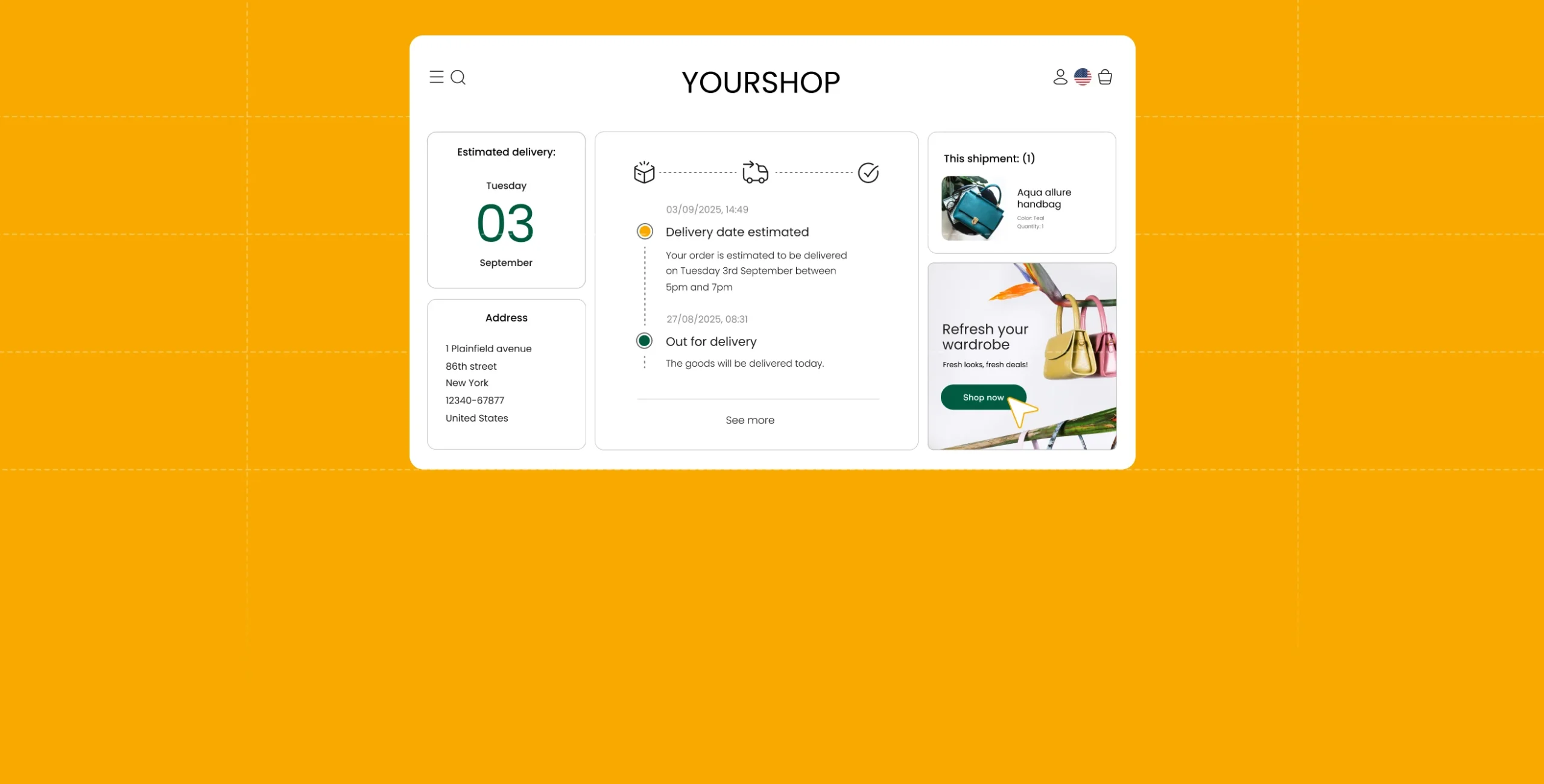Why parcelLab?
Discover why parcelLab is the go-to post-purchase partner for top retailers across the globe

Why parcelLab?
Discover why parcelLab is the go-to post-purchase partner for top retailers across the globe
Why parcelLab
Why top retailers choose parcelLab over the rest
AI and innovation
Transforming post-purchase with AI
PPX maturity curve
Discover where you stand on the curve
PPX Institute
Turn transactional relationships into customers for life
Post-purchase audit
Experience your brand the way your customers do
Platform
Platform support
PLATFORM
Meet the platform
The industry’s first and only PPX platform tailor-made for retailers
WHAT'S NEW
Benchmarking
Benchmark against the industry in real-time
Copilot
Turn delivery anxiety into customer satisfaction with AI
AI Email Editor
Streamline operations and reduce complexity with AI-powered automation
Campaign Manager 2.0
Run campaigns that drive revenue
Smart Survey
Collect feedback and drive improvements


OVERVIEW
Enhance delivery experience
Seize control of your delivery experience
CAPABILITIES
Track & communicate
Keep your customers engaged
Set up a branded tracking portal
Keep customers in your ecosystem
Create personalized journeys
Deliver the right message, at the right time
Run targeted campaigns
Create campaigns that convert
Predict delivery delays
See delivery issues before they happen and take proactive action
Streamline claims management
Reclaim time, revenue, and customer trust
Resolve customer inquiries
Empower your customer service teams

OVERVIEW
Make returns seamless
Transform customer dissatisfaction into revenue retention by digitizing returns and exchanges.
CAPABILITIES
Track and inform returns status
Create a seamless returns experience that retains customers
Self-service returns portal
Let customers register returns with ease
Personalize returns journey
Encourage exchanges over refunds
Forecast returns volume
Anticipate return patterns before they happen
Offer flexible returns
Give your customers versatile return options that cater to their preferences


OVERVIEW
AI-powered post-purchase
Optimize every post-purchase interaction with parcelLab's AI agents
CAPABILITIES
Execute with AI
Harness the power of AI agents
Predict with AI
Stay ahead with real-time insights & forecasts
Simplify with AI
Cut complexity & streamline operations
Personalize with AI
Deliver tailored experiences

Solutions
Reduce WISMO & WISMR calls
Keep customers in the loop & support smarter
Turn returns into revenue
Make returns seamless, maximize revenue
Manage complex post-purchase scenarios
Handle exceptions, claims & logistics
Optimize post-purchase campaigns
Boost engagement & drive conversions
Enhance personalization and engagement
Create 1:1 tailored experiences
Resources
Company

Why parcelLab?
Discover why parcelLab is the go-to post-purchase partner for top retailers across the globe
Why parcelLab
Why top retailers choose parcelLab over the rest
AI and innovation
Transforming post-purchase with AI
PPX maturity curve
Discover where you stand on the curve
PPX Institute
Turn transactional relationships into customers for life
Post-purchase audit
Experience your brand the way your customers do
PLATFORM
Meet the platform
The industry’s first and only PPX platform tailor-made for retailers
WHAT'S NEW
Benchmarking
Benchmark against the industry in real-time
Copilot
Turn delivery anxiety into customer satisfaction with AI
AI Email Editor
Streamline operations and reduce complexity with AI-powered automation
Campaign Manager 2.0
Run campaigns that drive revenue
Smart Survey
Collect feedback and drive improvements

OVERVIEW
Enhance delivery experience
Seize control of your delivery experience
CAPABILITIES
Track & communicate
Keep your customers engaged
Set up a branded tracking portal
Keep customers in your ecosystem
Create personalized journeys
Deliver the right message, at the right time
Run targeted campaigns
Create campaigns that convert
Predict delivery delays
See delivery issues before they happen and take proactive action
Streamline claims management
Reclaim time, revenue, and customer trust
Resolve customer inquiries
Empower your customer service teams

OVERVIEW
Make returns seamless
Transform customer dissatisfaction into revenue retention by digitizing returns and exchanges.
CAPABILITIES
Track and inform returns status
Create a seamless returns experience that retains customers
Self-service returns portal
Let customers register returns with ease
Personalize returns journey
Encourage exchanges over refunds
Forecast returns volume
Anticipate return patterns before they happen
Offer flexible returns
Give your customers versatile return options that cater to their preferences

OVERVIEW
AI-powered post-purchase
Optimize every post-purchase interaction with parcelLab's AI agents
CAPABILITIES
Execute with AI
Harness the power of AI agents
Predict with AI
Stay ahead with real-time insights & forecasts
Simplify with AI
Cut complexity & streamline operations
Personalize with AI
Deliver tailored experiences

Reduce WISMO & WISMR calls
Keep customers in the loop & support smarter
Turn returns into revenue
Make returns seamless, maximize revenue
Manage complex post-purchase scenarios
Handle exceptions, claims & logistics
Optimize post-purchase campaigns
Boost engagement & drive conversions
Enhance personalization and engagement
Create 1:1 tailored experiences
Resources
Company

Transform returns from a customer pain point into a strategic advantage. This guide reveals how optimizing your returns experience can unlock hidden revenue potential and boost customer loyalty.
Returns aren’t just a necessary process. They’re a unique opportunity to engage customers, drive repeat purchases, and create a seamless brand experience that fosters long-term loyalty.
Every return order process creates additional customer touchpoints with the potential to drive engagement, traffic, and incremental revenue
Retailers that optimize their returns process see tangible benefits in customer satisfaction and revenue growth. These key stats highlight the impact of a strategic, customer-centric returns approach.
of shoppers are willing to pay for product returns
of shoppers would opt for an immediate voucher over a refund
of shoppers asked for better product descriptions
Despite the potential of returns to drive engagement and sales, common obstacles prevent many retailers from fully leveraging this opportunity. Identifying and addressing these challenges is key to unlocking value.
Outsourcing communications limits control over the customer experience and reduces opportunities to drive revenue through returns.
Incomplete or inaccurate data prevents personalized communication and the use of valuable touchpoints during the return journey.
Fragmented customer or order data hinders the ability to offer relevant alternatives like exchanges or instant credit.
Generic return experiences fail to capitalize on the heightened customer engagement during the return process.
An error has occurred, please try again later.An error has occurred, please try again later.
By submitting the form, you agree to receive marketing information according to our Privacy Policy. You can unsubscribe at any time.